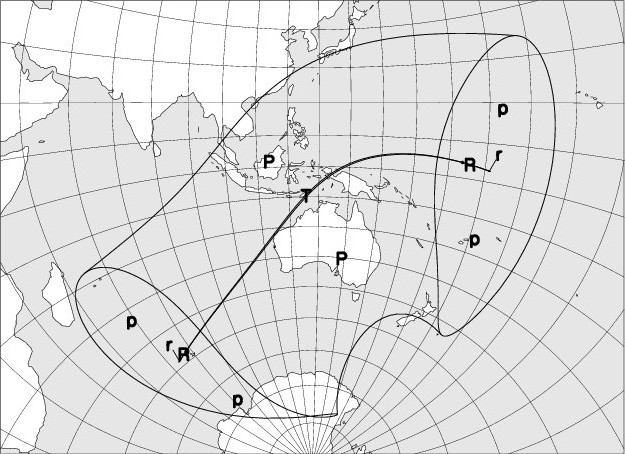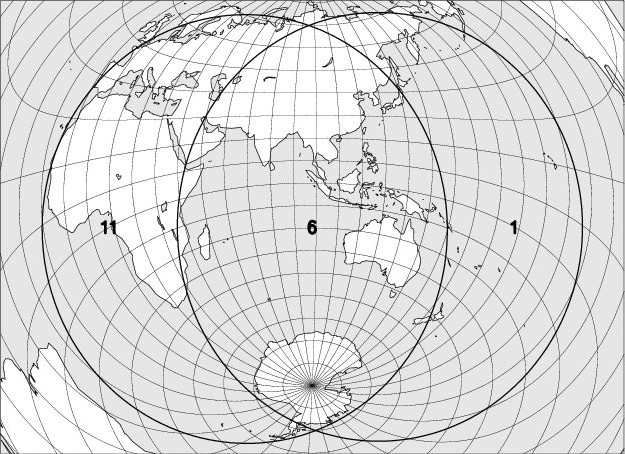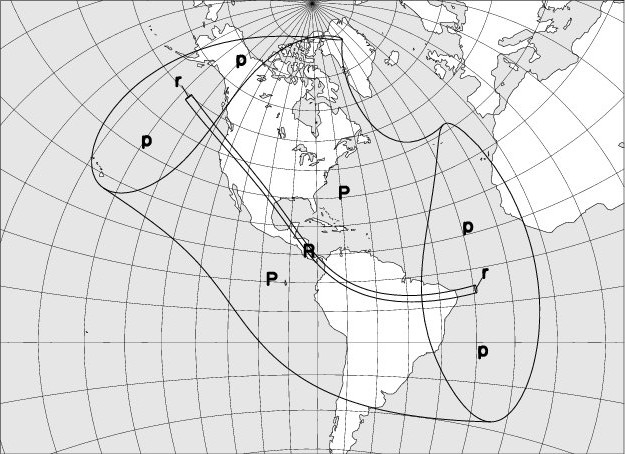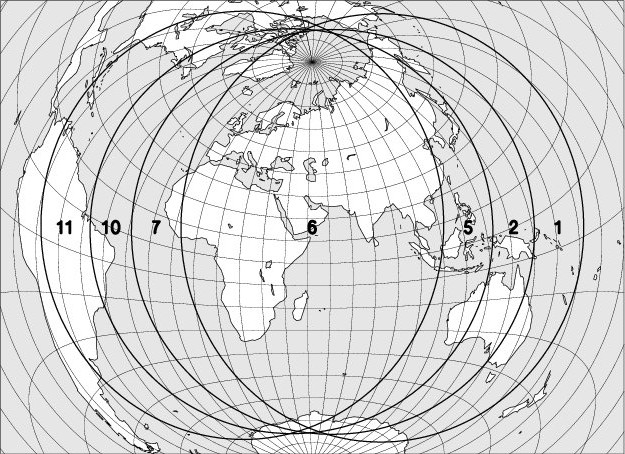In 2023, there will be four eclipses: two solar eclipses and two lunar eclipses
| Date | Type | Visibility |
| 20 April 2023 | Solar eclipse, successively annular, total and annular | Invisible in Belgium |
| 5 May 2023 | Penumbral lunar eclipse | Partially visible in Belgium |
| 14 October 2023 | Annular solar eclipse | Invisible in Belgium |
| 28 October 2023 | Partial lunar eclipse | Visible in Belgium |
I – 20 April 2023 – Solar eclipse, successively annular, total and annular, invisible in Belgium
| Phase | Universal time | Longitude | Latitude |
| Eclipse begins | 01h34,4 | 075 38 E | 40 18 S |
| Annular eclipse begins | 02h37,1 | 063 15 E | 48 32 S |
| Central eclipse begins | 02h37,1 | 063 37 E | 48 27 S |
| Total eclipse begins | 02h37,3 | 067 57 E | 47 29 S |
| Central eclipse at local apparent noon | 03h55,6 | 120 52 E | 14 50 S |
| Maximum of the eclipse | 04h12,6 | 124 49 E | 10 36 S |
| End of the total eclipse | 05h55,5 | 173 43 E | 04 14 N |
| End of the central eclipse | 05h56,6 | 178 49 W | 02 55 N |
| End of the annular eclipse | 05h56,7 | 178 34 W | 02 53 N |
| End of the eclipse | 06h59,4 | 167 29 E | 11 12 N |
The map below shows the region where the eclipse is observable. The explanation of the codes used can be found at the bottom of the page.

The duration of the totality phase along the centrality line will reach a maximum of 1m 21s at a point located at 126° of longitude east and 10° of latitude south. The duration of the annular phase along the line of centrality will be maximum at the end of the eclipse (9s).
II – 5 May 2023 – Penumbral lunar eclipse, partially visible in Belgium
| Phase | Universal Time | Longitude | Latitude | Position angle | Altitude at Uccle/Ukkel |
| Penumbral eclipse begins | 15h12,1 | 129 39 E | 16 46 S | 072 E | – |
| Maximum of the eclipse | 17h23,0 | 098 01 E | 17 15 S | 023 E | – |
| Moonrise at Uccle/Ukkel | 19h20,5 | 069 38 E | 17 40 S | 337 E | 0 |
| Penumbral eclipse ends | 19h33,8 | 066 26 E | 17 42 S | 334 E | +02 |
The longitude and the latitude refer to the point on Earth where the Moon is at that time at its zenith. The position angle is defined from the imaginary line that connects the center of the lunar disc to the center of the Earth’s shadow. It is measured at the center of the lunar disc, from the North, in an anti-clockwise direction. At the beginning and at the end of the penumbra and shadow phases, it is the position angle of the contact point. The altitude and times of the Moon’s rise and fall are calculated for its center, without taking refraction into account.
Magnitude of the eclipse: 0.989, the diameter of the lunar disk being taken as the unit.
The map below shows the region where the eclipse is observable. The explanation of the codes used can be found at the bottom of the page.

III – 14 October 2023 – Annular solar eclipse, invisible in Belgium
| Phase | Universal time | Longitude | Latitude |
| Eclipse begins | 15h03,8 | 132 32 W | 41 19 N |
| Annular eclipse begins | 16h10,2 | 146 54 W | 49 00 N |
| Central eclipse begins | 16h12,4 | 146 55 W | 49 21 N |
Central eclipse at the local apparent noon |
17h36,6 | 087 40 W | 16 58 N |
| Maximum of the eclipse | 18h03,4 | 082 20 W | 10 27 N |
| End of the central eclipse | 19h46,8 | 029 23 W | 05 41 S |
| End of the annular eclipse | 19h49,0 | 029 37 W | 06 03 S |
| Fin de l’éclipse | 20h55,3 | 045 01 W | 13 44 S |
The map below shows the region where the eclipse is observable. The explanation of the codes used can be found at the bottom of the page.

The duration of the annular phase along the centrality line will reach a maximum of 5m 13s at a point located at 80° of longitude west and 8° of latitude north.
IV – 28 October 2023 – Partial lunar eclipse, visible in Belgium
| Phase | Universal time | Longitude | Latitude | Position angle | Altitude at Uccle/Ukkel |
| Penumbral eclipse begins | 17h59,9 | 084 25 E | 13 31 N | 102 E | +16 |
| Partial eclipse begins | 19h34,4 | 061 35 E | 13 55 N | 134 E | +30 |
| Maximum of the eclipse | 20h14,0 | 052 02 E | 14 05 N | 155 E | +36 |
| Partial eclipse ends | 20h53,6 | 042 28 E | 14 15 N | 176 E | +42 |
| Penumbral eclipse ends | 22h28,3 | 019 37 E | 14 38 N | 208 E | +51 |
The longitude and the latitude refer to the point on Earth where the Moon is at that time at its zenith. The position angle is defined from the imaginary line that connects the center of the lunar disc to the center of the Earth’s shadow. It is measured at the center of the lunar disc, from the North, in an anti-clockwise direction. At the beginning and at the end of the penumbra and shadow phases, it is the position angle of the contact point. The altitude and times of the Moon’s rise and fall are calculated for its center, without taking refraction into account.
Magnitude of the eclipse: 0.128, the diameter of the lunar disk being taken as the unit.
The map below shows the region where the eclipse is observable. The explanation of the codes used can be found at the bottom of the page.

Explanations:
The codes used on the maps to indicate the moon eclipse visibility are: entry into the darkness is visible in regions 1 to 6, entry into the darkness in regions 2 to 7, the beginning of the totality in regions 3 to 8. The exits of the totality, the shadow and the penumbra are respectively observable in regions 4 to 9, 5 to 10, and 6 to 11. In region 6, the entire eclipse can be observed, in regions 5 to 7 the umbral phases are observable; in regions 4 to 8 the totality is fully visible.
On solar eclipse visibility maps, the following codes are used:
“P”: Partial eclipse of the Sun, visible.
“p”: Partial eclipse of the Sun, partly visible.
“R”: Annular eclipse, whose annular phase is fully observable.
“r”: Annular eclipse, whose annular phase is partially observable.
“T”: Total eclipse, whose totality phase is fully observable.
“t”: Total eclipse, whose totality phase is partially observable.
The basic data used to write the eclipse chapter were borrowed from the DE405 digital integration, kindly provided by the Jet Propulsion Laboratory. To move from Terrestrial Time (TT) to Universal Time (UT), the following provisional relationship was used:
UT = TT – 69.0 s
